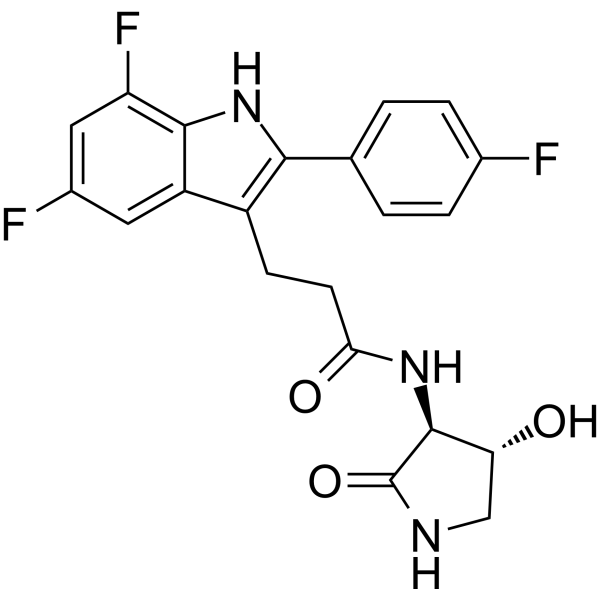
Inaxaplin
CAS No. 2446816-88-0
Inaxaplin( VX-147 )
Catalog No. M28276 CAS No. 2446816-88-0
Inaxaplin is an apolipoprotein L1 ( APOL1 ) function inhibitor (WO2020131807, compound 2). Inaxaplin can be used for the research of kidney disease.
Purity : >98% (HPLC)
 COA
COA
 Datasheet
Datasheet
 HNMR
HNMR
 HPLC
HPLC
 MSDS
MSDS
 Handing Instructions
Handing Instructions
| Size | Price / USD | Stock | Quantity |
| 2MG | 372 | Get Quote |


|
| 5MG | 620 | Get Quote |


|
| 10MG | 881 | Get Quote |


|
| 25MG | 1314 | Get Quote |


|
| 50MG | 1764 | Get Quote |


|
| 100MG | 2385 | Get Quote |


|
| 200MG | Get Quote | Get Quote |


|
| 500MG | Get Quote | Get Quote |


|
| 1G | Get Quote | Get Quote |


|
Biological Information
-
Product NameInaxaplin
-
NoteResearch use only, not for human use.
-
Brief DescriptionInaxaplin is an apolipoprotein L1 ( APOL1 ) function inhibitor (WO2020131807, compound 2). Inaxaplin can be used for the research of kidney disease.
-
DescriptionInaxaplin is an apolipoprotein L1 ( APOL1 ) function inhibitor (WO2020131807, compound 2). Inaxaplin can be used for the research of kidney disease.(In Vitro):Inaxaplin is an apolipoprotein L1 function inhibitor.
-
In Vitro——
-
In Vivo——
-
SynonymsVX-147
-
PathwayOthers
-
TargetOther Targets
-
Recptor14-3-3 protein-protein interaction
-
Research Area——
-
Indication——
Chemical Information
-
CAS Number2446816-88-0
-
Formula Weight417.38
-
Molecular FormulaC21H18F3N3O3
-
Purity>98% (HPLC)
-
SolubilityIn Vitro:?DMSO : 50 mg/mL (119.79 mM)
-
SMILES——
-
Chemical Name——
Shipping & Storage Information
-
Storage(-20℃)
-
ShippingWith Ice Pack
-
Stability≥ 2 years
Reference
1.Mancini M, et al. A new nonpeptidic inhibitor of 14-3-3 induces apoptotic cell death in chronic myeloid leukemia sensitive or resistant to imatinib. J Pharmacol Exp Ther. 2011 Mar;336(3):596-604.
molnova catalog



related products
-
thermospermine
Thermospermine is a structural isomer of spermine and plays a role in the repression of xylem differentiation. Thermospermine can be used in studies about acting as a plant growth regulator and serving in the control of wood biomass production.
-
Dok-6 (263 - 275)
Dok-6 (263 - 275)
-
Vonlerolizumab
Vonlerolizumab(MOXR 0916) is a humanized IgG agonistic OX40-specific monoclonal antibody with potential antitumor activity for the study of tumors and immune diseases.



 Cart
Cart
 sales@molnova.com
sales@molnova.com


